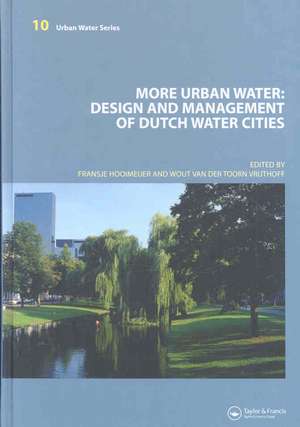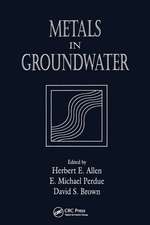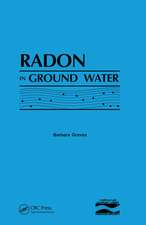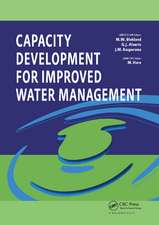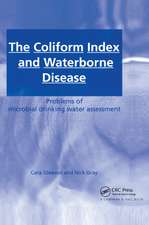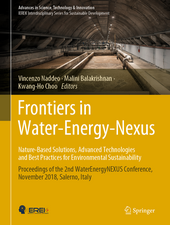More Urban Water: Design and Management of Dutch water cities: Urban Water Series
Autor Fransje Hooimeijer, Wout Toorn Vrijthoffen Limba Engleză Hardback – 20 sep 2007
With an integral approach, this book treats the relation of urbanism and water management in Dutch water cities. It also treats the financial aspects of the adjustment of existing water systems to meet the changes in the urban hydrological cycle. It presents the typology of typical current and future Dutch water cities, their urban function and the ecological and technical aspects. Separate chapters deal with the transformation of the historical city, the consolidation of the inter-war city and the restructuring of the post-war city to meet future conditions. The final chapter presents a comparison of the Dutch situation with South Korean (Seoul), Japanese (Tokyo) and German (Ruhr area) urban areas.
Preț: 683.99 lei
Preț vechi: 991.66 lei
-31% Nou
Puncte Express: 1026
Preț estimativ în valută:
130.92€ • 142.26$ • 110.05£
130.92€ • 142.26$ • 110.05£
Carte tipărită la comandă
Livrare economică 21 aprilie-05 mai
Preluare comenzi: 021 569.72.76
Specificații
ISBN-13: 9780415453585
ISBN-10: 0415453585
Pagini: 240
Ilustrații: Illustrations, maps
Dimensiuni: 174 x 246 x 20 mm
Greutate: 0.64 kg
Ediția:1
Editura: CRC Press
Colecția CRC Press
Seria Urban Water Series
ISBN-10: 0415453585
Pagini: 240
Ilustrații: Illustrations, maps
Dimensiuni: 174 x 246 x 20 mm
Greutate: 0.64 kg
Ediția:1
Editura: CRC Press
Colecția CRC Press
Seria Urban Water Series
Public țintă
Postgraduate and ProfessionalCuprins
Chapter 1: Introduction: water's changing context
1.1 Introduction
1.2 Climate change
1.3 The Netherlands water land
1.4 The organisation of a water management authority
1.5 Giving space instead of holding water back
1.6 Institutional policy frameworks
1.7 Urban water management
1.8 Expanding the water storage capacity
1.9 Approach on a spatial level
1.10 Costs and sources of funding
Chapter 2: The form and function of water in the city
2.1 Introduction
2.2 Basic types of water town
2.3 The expansion of water towns
2.4 The overture to the city
2.5 Expansions in the polder in the interwar years
2.6 Water towns after the war
2.7 The primordial Dutch talent
2.8 The future: Rotterdam Water City 2035 Govert Geldof
Chapter 3: The urban design issues in existing cities
3.1 Introduction
3.2 The state of affairs in the prewar city
3.3 The structure of the prewar city
3.4 The issues in the prewar city by theme
3.5 The issue in the prewar city
3.6 The state of affairs in the post-war city
3.7 The post-war urban expansion
3.8 The common approach in the post-war city
3.9 New opportunities in restructuring the post-war city
Chapter 4: The water issues in the existing city
4.1 Introduction
4.2 Water flows
4.3 Guiding principles: comprehensive and sustainable
4.4 Guiding models
4.5 Water issues in the planning process
Chapter 5: More water in the historic city centre: transformation
5.1 Introduction
5.2 Catharijnesingel, Utrecht
5.3 Old Harbour, Breda
5.4 East city centre, Delft
5.5 Conclusion
Chapter 6: More water in the city, from 1850 to 1945: consolidation
6.1 Introduction
6.2 Museumpark, Rotterdam
6.3 Vogelwijk, The Hague
6.4 Conclusion
Chapter 7: More water in the post-war city: restructuring
7.1 Introduction
7.2 Poptahof, Delft
7.3 Wielwijk, Dordrecht
7.4 Schalkwijk, Haarlem
7.5 Conclusion
Chapter 8: International comparison
8.1 Introduction
8.2 Seoul (South Korea)
8.3 Tokyo (Japan)
8.4 The Ruhr (Germany)
Chapter 9: Conclusions
Bibliography
1.1 Introduction
1.2 Climate change
1.3 The Netherlands water land
1.4 The organisation of a water management authority
1.5 Giving space instead of holding water back
1.6 Institutional policy frameworks
1.7 Urban water management
1.8 Expanding the water storage capacity
1.9 Approach on a spatial level
1.10 Costs and sources of funding
Chapter 2: The form and function of water in the city
2.1 Introduction
2.2 Basic types of water town
2.3 The expansion of water towns
2.4 The overture to the city
2.5 Expansions in the polder in the interwar years
2.6 Water towns after the war
2.7 The primordial Dutch talent
2.8 The future: Rotterdam Water City 2035 Govert Geldof
Chapter 3: The urban design issues in existing cities
3.1 Introduction
3.2 The state of affairs in the prewar city
3.3 The structure of the prewar city
3.4 The issues in the prewar city by theme
3.5 The issue in the prewar city
3.6 The state of affairs in the post-war city
3.7 The post-war urban expansion
3.8 The common approach in the post-war city
3.9 New opportunities in restructuring the post-war city
Chapter 4: The water issues in the existing city
4.1 Introduction
4.2 Water flows
4.3 Guiding principles: comprehensive and sustainable
4.4 Guiding models
4.5 Water issues in the planning process
Chapter 5: More water in the historic city centre: transformation
5.1 Introduction
5.2 Catharijnesingel, Utrecht
5.3 Old Harbour, Breda
5.4 East city centre, Delft
5.5 Conclusion
Chapter 6: More water in the city, from 1850 to 1945: consolidation
6.1 Introduction
6.2 Museumpark, Rotterdam
6.3 Vogelwijk, The Hague
6.4 Conclusion
Chapter 7: More water in the post-war city: restructuring
7.1 Introduction
7.2 Poptahof, Delft
7.3 Wielwijk, Dordrecht
7.4 Schalkwijk, Haarlem
7.5 Conclusion
Chapter 8: International comparison
8.1 Introduction
8.2 Seoul (South Korea)
8.3 Tokyo (Japan)
8.4 The Ruhr (Germany)
Chapter 9: Conclusions
Bibliography
Descriere
An integral approach to the relation of urbanism and water management in Dutch water cities and to adjustments necessary to upgrade water management systems to the requirements imposed by a changing amount or precipitation and by changing function, technology and scale of urban areas. Separate chapters deal with the transformation of the historical city, the consolidation of the inter-war city and the restructuring of the post-war city to meet future conditions. Comparisons of the Dutch situation with South Korean, Japanese and German urban areas is also included.
